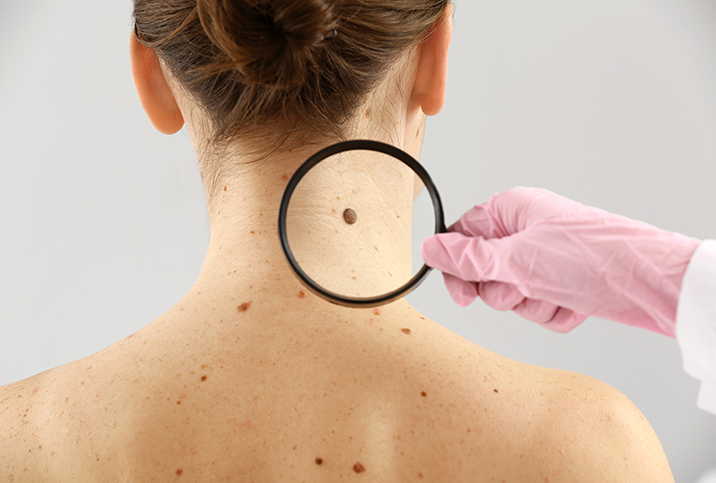A Beginner's Guide to Skin Tags, Moles and Skin Cancer

Human skin has a seemingly infinite spectrum of colors, textures and features. This can make it more difficult to recognize the red flags for skin cancer: What's worrisome and what's just human diversity? Talking to your dermatologist is always the safest bet, but there's some information that you should keep on hand for yourself as well.
A crash course in dermatology
Dermatology refers to medicine related primarily to skin, but also hair, nails and other cosmetic aspects. While dermatological conditions are fairly prominent, sometimes it's difficult to distinguish between typical and atypical skin lesions.
"Any change in a skin lesion, spot or mole should prompt medical evaluation," said Daniel Ward, M.D., owner and founder of Ward MD Facial Plastic Surgery and adjunct associate professor at the University of Utah School of Medicine. "A simple biopsy can be the difference between a relatively simple stage 1 skin cancer and an untreatable stage IV skin cancer."
Moles vs. skin tags
Often, you'll recognize the kind of lesions Ward recommends biopsying by their color. This occurs in part due to melanocytes. Sara Kurian Lamb, M.D., and assistant professor of dermatology at the Johns Hopkins University School of Medicine, describes melanocytes as the specific cells responsible for giving skin its natural color. Melanocytes are distributed evenly throughout the epidermis and act as protection from the sun's UV rays via the production of melanin.
"Moles develop in areas where melanocytes cluster together," Lamb said. She emphasized that all skin types are susceptible to moles, but the quantity is influenced by genetics. Patients may also encounter skin tags, which are clusters of collagen and blood vessels trapped underneath thicker skin. These, however, are less worrisome: "Skin tags are small outgrowths and are composed of normal skin cells."
"Anyone can develop skin tags and moles," said Nkem Ugonabo, M.D., MPH and FAAD at UnionDerm. "People who are obese, pregnant or elderly may be more likely to develop skin tags.
"Skin tags are benign growths that are often soft, brown and fleshy, and may hang off a 'stalk,'" she continued. "Moles, also known as nevi, can be flat or elevated and range in color from skin color to dark brown/black."
Lamb noted that although moles and skin tags can appear anywhere on the body, skin tags are more likely to appear in areas of friction, such as around the eyes, neck, axillae (armpits), under breasts and on the inner thighs.
While most moles appear within the first 20 years—some being congenital—skin tags develop slowly over time.
People can have any number of moles and skin tags. While most moles appear within the first 20 years—some being congenital—skin tags develop slowly over time. Moles may have minor changes over the years, most being harmless, but certain shifts can imply skin cancer. Stay on top of cancer screenings to ascertain the potential danger.
Though skin tags are benign, they can become agitated due to friction and even be twisted or torn off, causing bleeding.
"If a skin tag becomes irritated, a dermatologist can assist with its removal, often by numbing the skin tag and then doing a snip removal," Ugonabo said.
Lamb noted skin tag removal can be either cosmetic or medically necessary. If the purpose is purely cosmetic, it won't typically be covered by insurance, as opposed to when the tags cause inflammation or other ailments.
Because tags and moles can look alike, self-removal is not recommended. Depending on the extent, size and location of the lesion, a dermatologist will use a variety of removal methods, including excision, cryotherapy or burning.
"All of these are typically best treated by surgery," Ward said. "There can be other treatments, but nothing is as good as surgery. [If cancerous,] the procedure involves removing the cancer and then looking at the edges of the removed cancer under the microscope to see if any cancer is remaining."
He explained this method helps minimize the amount of tissue that needs to be removed and yields the lowest possible recurrence rates.
Skin cancer
All three experts reported that skin cancer is the most common type of cancer in the United States. In fact, more than 9,500 people receive a skin cancer diagnosis every day in the U.S., and two people will die of skin cancer every hour. That being said, most types of skin cancer are not deadly, such as basal cell carcinoma, which carries a good prognosis. If you're diagnosed with skin cancer of any kind, it's imperative to talk to your doctor about what to expect.
Skin cancer, like other cancers, can be more likely in people with a family history. You may want to undergo genetic testing to assess your risk, though skin cancer is not always hereditary.
Because of this, regularly checking skin lesions independently or through a dermatologist is crucial. There are many guides and infographics detailing how to spot suspicious moles. Ugonabo recommends looking for the ABCDEs of skin cancer, as follows:
- Asymmetry (one half doesn't look like the other half)
- Border (irregular or uneven)
- Color (variety of colors/shapes or uneven pigment)
- Diameter (bigger than 6 mm in diameter; about the size of a pencil eraser)
- Evolution (changes in size, shape or color)
"We call a mole abnormal if the melanocytes start to display any cancerous features and we grade them as mild, moderate or severely atypical," Lamb said.
There are three major types of skin cancer: basal cell carcinoma, squamous cell carcinoma and melanoma.
"By far, the most common type of skin cancer is basal cell carcinoma," Ward said. "Squamous cell carcinoma and melanoma are the next common types. Although the prognosis is quite good for basal cell carcinoma and squamous cell carcinoma, for melanoma, it is highly dependent upon the depth of the skin. The deeper it is, the more likely it will be to spread throughout the body."
Ward put special emphasis on the importance of cancer size.
"The enormity of the difference [in size] can be a matter of life and death for cancers like melanoma or a matter of a small defect versus a large defect," he explained. "A small defect might be able to be reconstructed with the relatively simple technique, but a larger defect may require a complicated, multi-stage reconstruction using tissue from other parts of the body. And although these reconstructions work amazingly well, they are complex and definitely require technical expertise by the surgeon and patience from the patient."
Risk factors
There are many risk factors for developing skin cancer, although Ugonabo, Ward and Lamb each asserted frequent UV exposure as the primary culprit. Weakened immune systems, a history of sunburns and exposure to carcinogens are among others. Additionally, Ward pointed out people with fair skin, blue eyes and light-colored hair are at higher risk because they have less of the melatonin needed for UV protection. With that being said, people with darker pigmentation should still wear skin protection during long-term outdoor activities.
"Ultraviolet radiation exposure causes mutations in our skin cells—which our body usually repairs or removes—but if the mutated cells develop a way to hide from our repair mechanisms, then cancer can develop," Lamb explained.
She pointed out that prognosis worsens if cancers involve local nerves and lymph nodes, in which case additional treatment is necessary.
Combating the sun's harmful UV rays with protective clothing or sunscreen is your best base defense.
The upside is that there are several ways to prevent skin cancer, and every expert reported the outlook is much better with early intervention.
Combating the sun's harmful UV rays with protective clothing or sunscreen is your best base defense. Ward and Ugonabo specifically recommend broad-spectrum varieties of sunscreen with both UV-A and UV-B protection and an SPF of at least 30. Avoid carcinogens, and if you have a history of cancer, make efforts to circumvent reoccurrence—Lamb emphasized the significantly higher rates of cancer for those who have already had it. Unsurprisingly, all experts agreed that tanning beds should never be used.
"If you're concerned about any spots on your body, I would strongly suggest erring on the side of caution and seeing a board-certified dermatologist for a skin check," Ugonabo said.
"It's always a good idea, especially in adulthood, to establish with a dermatologist so they can give you a baseline assessment and go over any individual risk factors," Lamb said.


















